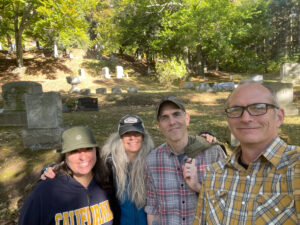
From the editor
One of my favorite family activities this time of year is to wander local cemeteries. Some people find that a bit odd, but cemeteries are

One of my favorite family activities this time of year is to wander local cemeteries. Some people find that a bit odd, but cemeteries are

BUFFALO REGULAR CLUB MEETINGS African Violet & Gesneriad Society of WNY meets the third Tuesday of the month, September–August, at 7 p.m., Greenfield Health & Rehab

Picture this: you’re admiring your yard on a warm afternoon when you notice dark, wet streaks running down your favorite maple. The bark looks slimy

INGREDIENTS: 2 acorn squash, halved and seeded 1–2 tablespoons olive oil 1/2 pound pork sausage, cooked and drained 1 apple, diced 1/2 cup chopped nuts

Migration season is always an exciting time in the spring, but there is also a lot of bird movement that happens in the fall and
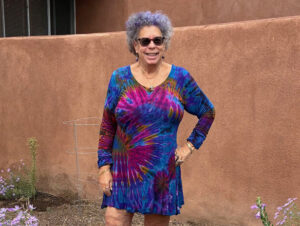
It’s taken me until age seventy-two to learn the joy and fulfillment of having a garden. My mom was an avid and respected gardener in

I love setting up my fresh cut Christmas tree each year. It is one of my favorite holiday traditions. I have always loved evergreen trees,

HYDROPONIC GARDENING Hydroponics is the method of growing plants in nutrient-rich water rather than soil, making it an interesting option for indoor gardening as Rochester’s
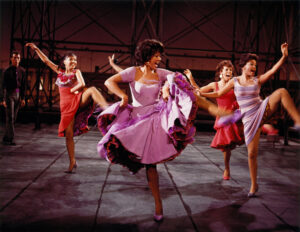
Moreno awarded the George Eastman Award Rita Moreno radiated youthfulness and humor from the stage at the Dryden theater in Rochester. Moreno was answering press
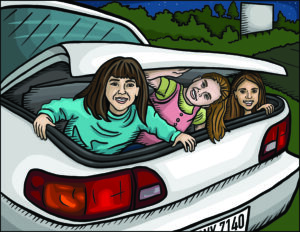
An ominous thump signaled the closing of the trunk above me, encasing me in darkness and an ear-splitting silence. My legs searched into the dark
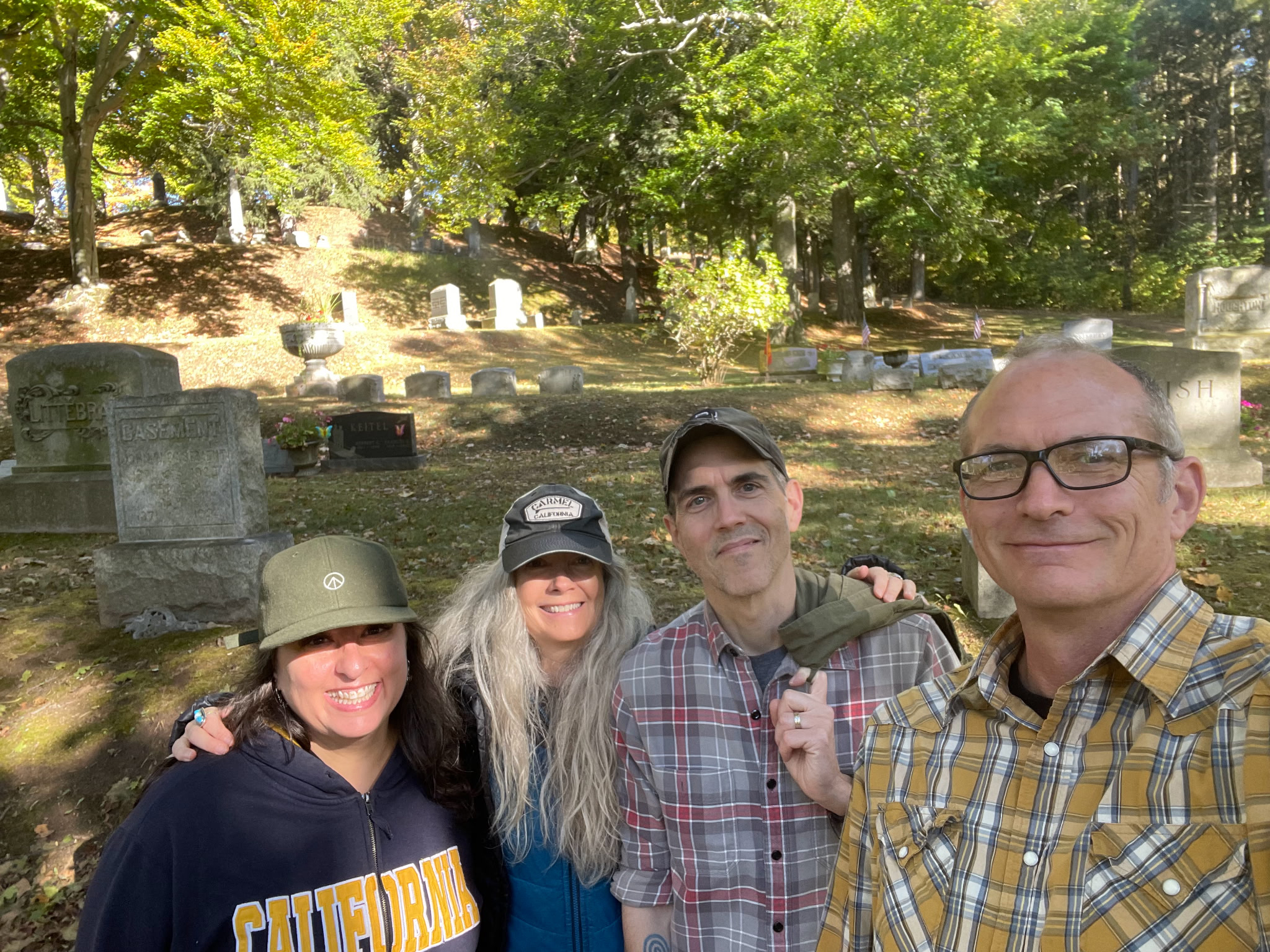

One of my favorite family activities this time of year is to wander local cemeteries. Some people find that a bit odd, but cemeteries are some of the most beautiful places to experience nature and wildlife. The rural cemetery movement of the nineteenth century invited Americans to not only utilize cemeteries for the internment of their beloved dead but also as parks. Benches, sweeping areas of grass, and a variety of fountains and monuments make them the perfect place to picnic or take a walk. Many cemeteries have gardens and a variety of trees and shrubs. I adore the birding at local cemeteries as well. In fact, the famous Mount Hope Cemetery in Rochester is a certified Audubon sanctuary as is White Haven Memorial Park in Pittsford. I love to spend quiet time in area cemeteries identifying bird with my Merlin app on my phone. (If you like birds you must download the Merlin app from the Cornell Lab of Ornithology!)
This is a picture of me, my husband (Paul Moyer), and two friends at Mount Albion Cemetery in Albion. The changing leaves were gorgeous, and we were happily surprised with a variety of lovely birds, too. So, when it is too cold to garden, throw on a coat and enjoy walking around your local cemetery!

This article originally appeared in the November/December 2025 issue of Upstate Gardeners’ Journal.

BUFFALO
REGULAR CLUB MEETINGS
African Violet & Gesneriad Society of WNY meets the third Tuesday of the month, September–August, at 7 p.m., Greenfield Health & Rehab Facility, 5949 Broadway, Lancaster. [email protected].
Alden Garden Club meets the second Wednesday of the month (except July and August) at 7 p.m., Alden Community Center, West Main St., Alden. New members and guests welcome. Plant sale each May. 716-937-7924.
Amana Garden Club meets the second Wednesday of the month (except January) at Ebenezer United Church of Christ, 630 Main St., West Seneca. Visitors welcome. 716-844-8543, [email protected].
Amherst Garden Club meets the fourth Wednesday of the month (except December, March, July, and August) at 10 a.m., St. John’s Lutheran Church, Main St., Williamsville. New members and guests welcome. 716-836-5397.
Bowmansville Garden Club meets the first Monday of the month (except June, July, August, and December) at 7 p.m., Bowmansville Fire Hall, 36 Main St., Bowmansville. New members and guests welcome. For more information, 716-361-8325.
Buffalo Area Daylily Society. East Aurora Senior Center, 101 King St., East Aurora. The society is a friendly group who get together to enjoy daylilies. Plant Sales in August. Open gardens, June–August. Facebook.
Buffalo Bonsai Society meets every second Saturday at 1 p.m. at ECC North Campus, STEM Bldg., 6205 Main St., Williamsville, NY 14221. Picnic/Auction; 9/14, (Rochester, NY) Penjing Bonsai; 10/12, Mark Arpag; 11/9, Suiseki with Sean Smith. buffalobonsaisociety.com.
East Aurora Garden Club meets at noon on the second Monday of each month, except January. The clubs meets at Nativity Lutheran Church, 970 E. Main St., East Aurora, NY (just west of the 400 Expressway exit). The club’s objective is to stimulate, create interest, and promote education on horticulture, the art of gardening, flower arranging, and environmental conservation; and to promote the beautification of surrounding areas. For more information about the club or membership call 716- 912-1589.
Federated Garden Clubs NYS–District 8. Nancy Kalieta is the director; [email protected]. gardenclubsofwny.com.
Forest Stream Garden Club meets the third Thursday of the month (September–May) at 7 p.m., Presbyterian Village, 214 Village Park Dr., Williamsville and other locations. Summer garden teas and tours available. Ongoing projects include beautification of the Williamsville Meeting House, garden therapy at a local nursing home, youth gardening, and Victorian Christmas decorating. [email protected].
Friends of Kenan Herb Club meets the third Monday of the month at 2 p.m. at the Taylor Theater. New members are always welcome. kenancenter.org/herb-club.
Garden Club of the Tonawanda meets the third Thursday of the month at 6:30 p.m., Tonawanda City Hall, Community Room. Facebook.
Garden Friends of Clarence meets the second Wednesday of the month at 7 p.m., September– June, Town Park Clubhouse, 10405 Main St., Clarence. [email protected].
Gardens Buffalo Niagara open gardens on Thursdays and Fridays in July starts Thursday, July 11. Explore the beauty of gardens spread out in Erie and Niagara counties. Visit gardensbuffaloniagara.com/open-gardens-buffalo for more details and location information.
Hamburg Garden Club meets the second Wednesday of each month (except July and August) at 10 a.m. at the VFW Post 1419, 2985 Lakeview Rd, Hamburg, NY. Events include a June plant sale and July and August field trips. New members and guests are welcome. Contact [email protected].
Kenmore Garden Club meets the second Tuesday of the month (except July, August, and December) at 10 a.m., Kenmore United Methodist Church, 32 Landers Rd., Kenmore. Activities include guest speakers, floral designs, and community service. New members and guests are welcome. [email protected].
Ken-Sheriton Garden Club meets the second Tuesday of the month (except January) at 7 p.m., St. Mark’s Lutheran Church, 576 Delaware Rd. Kenmore. Monthly programs, artistic design, and horticulture displays. New members and guests welcome. 716- 833-8799, [email protected].
Lancaster Garden Club meets the second Wednesday of the month (except January, July, and August) at 7 p.m., St. John Lutheran Church, 55 Pleasant Ave., Lancaster. All are welcome. Facebook.
Lewiston Garden Club meets the fourth Monday of the month. See website for meeting information, lewistongardenfest.com/garden-club.html or contact at PO Box 32, Lewiston, NY 14092.
Niagara Frontier Botanical Society meets the second Tuesday of the month September through May at 7:30 p.m. (except April) at the Harlem Rd. Community Center, 4255 Harlem Rd., Amherst. Entrance is on the north side of the building. Meetings are open to the public.
Niagara Frontier Orchid Society (NFOS) usually meets the first Tuesday following the first Sunday (dates sometimes vary due to holidays, etc.), September– June, Botanical Gardens, 2655 South Park Ave., Buffalo. niagarafrontierorchids.org.
Orchard Park Garden Club meets the first Thursday of the month (except July and December) at 11:30 a.m. at St. John’s Lutheran Church, 4536 South Buffalo St., Orchard Park. Contact Diana Szczepanski at 716- 674-8970 for membership information. Guests are always welcome.
Ransomville Garden Club meets the third Wednesday or Saturday of the month at 5:45 p.m., Ransomville Community Library, 3733 Ransomville Rd., Ransomville. Meetings are open to all. Activities include community gardening projects, educational presentations, and June plant sale. bbonnie2313@ gmail.com.
Silver Creek-Hanover Garden Club meets the second Saturday of the month at 11 a.m., Silver Creek Senior Center, 1823 Lake Rd. (Rte. 5), Silver Creek. [email protected]
South Towns Gardeners meets the second Friday of the month (except January) at 9:30 a.m., West Seneca Senior Center. New members welcome.
Springville Concord Garden Club meets the first Friday of the month at 10 a.m. at the Concord Senior Center, 40 Commerce Dr., Springville, NY 14141. Meetings feature guest speakers on a variety of gardening and related topics. Annual July Garden Walk. Guests are welcome.
Town and Country Garden Club of LeRoy meets the second Wednesday of the month (except February) at 6:30 p.m., First Presbyterian Church, 7 Clay St., LeRoy 14482. Prospective members and guests are welcome. Contact: [email protected]. Facebook: facebook.com/GardenClubLeRoyNY.
Town and Country Garden Club of Williamsville generally meets the second Thursday of the month from 2–4 p.m. at the Ransom Oaks Community Club House, 101 Ransom Oaks Dr., East Amherst. Some meetings are held off site for garden tours and special events. The club maintains a garden at the Clearfield Library, 770 Hopkins Rd. Membership brochures with program information are available in the library. For information, contact [email protected].
Tropical Fish Society of Erie County meets the third Tuesday of the month at 7:30 p.m., Lake Erie Italian Club, 3200 South Park Ave., Lackawanna, NY 14218. tropical-fish-club-of-erie-county.com
Western New York Herb Study Group meets the second Wednesday of the month at 7 p.m., Buffalo and Erie County Botanical Gardens, 2655 South Park Ave., Buffalo. Facebook.
Western New York Honey Producers, Inc. Cornell Cooperative Extension of Erie County, 21 South Grove St., East Aurora. wnyhpa.org.
Western New York Hosta Society. The WNYHS was formed to encourage members to appreciate hostas and to provide them with access to quality new varieties. The group meets three times a year at the East Aurora Senior Center, 101 King St., East Aurora NY 14052. wnyhosta.com.
Western New York Hosta Society Breakfast Meetings are friendly get-togethers the first Saturday (winter months only) at 10 a.m., Forestview Restaurant, Depew, wnyhosta.com.
Western New York Iris Society meets at the Julia B Reinstein Library, 1030 Losson Rd., Cheektowaga, NY at 1:30 p.m. on the first Sunday of each month.
Western New York Rose Society meets the third Wednesday of each month at 7 p.m. St. Stephens-Bethlehem United Church of Christ, 750 Wehrle Dr., Williamsville. Check the Facebook page or website for meeting content, wnyrosesociety.net.
Youngstown Garden Club meets the second Wednesday of every month at 7 p.m., First Presbyterian Church, 100 Church St., Youngstown. Facebook.
FREQUENT HOSTS
BECBG: Buffalo & Erie County Botanical Gardens, 2655 South Park Ave., Buffalo, NY 14218. 716/827-1584; buffalogardens.com.
REIN: Reinstein Woods Nature Preserve, 93 Honorine Drive, Depew, NY 14043. 716-683- 5959; reinsteinwoods.org.
F- Indicates activities especially appropriate for children and families.
CLASSES / EVENTS
F Ongoing: Feed the fish, Regular admission for the day is included after the event. All tickets must be purchased ahead of time online. Check the website for all dates and times. BECBG
T Ongoing: Mini Tour Fridays, 2–3 p.m. on select Fridays. Guests can learn all about the highlights of the gardens' first six greenhouses from the knowledgeable Garden Guides on a 30-minute "mini tour." After, they can enjoy the rest of the conservatory at their own pace. Check the website for all dates. BECBG
Ongoing: Poinsettias After Dark, 5–9 p.m. Experience the magic of the holidays during Poinsettias After Dark. Escape Buffalo's cold winter nights and enjoy a charming and calming evening exploring the carefully curated collection of pretty poinsettias. Begins November 28, check the website for all dates. BECBG
November 1: Crafting Cordage, 10 a.m. This class teaches students how to identify and harvest dogbane for cordage in a hands-on workshop celebrating Haudenosaunee ethnobotany–the study of how plants have been traditionally used for food, medicine, and other purposes. Registration required; call 716-683-5959. REIN
F November 1, 2: topiary Tales, 10 a.m.–4 p.m. Enter a real-life storybook as the conservatory is transformed to tell the stories of various woodland characters through topiaries. BECBG
November 8: Fabulous Fungi, 11 a.m. A mushroom enthusiast leads this beginner-friendly walk where you can try to identify as many mushrooms as possible. For ages 12 and older. Registration required; call 716-683-5959. REIN
November 15: Owls of Reinstein Woods, 7 p.m. Learn about the owls that live in the woods during a nighttime adventure in search of these nocturnal birds. Registration required; call 716-683-5959. REIN
November 21: Poinsettia Exhibit, Step into the warm embrace of the conservatory for the Botanical Gardens' annual Poinsettia Exhibit. Ongoing through January 4. Cost included with admission. BECBG
F November 29: Family Nature Quest: Turkey Talk, Flock into the world of turkeys, turkey vultures, and even turkey tail fungus in this family adventure. Registration required; call 716-683-5959. REIN
ITHACA
REGULAR CLUB MEETINGS
Adirondack Chapter, North American Rock Garden Society (ACNARGS) Meetings are open to all. Check the current newsletter on the website for meeting location: acnargs.org or Facebook.com/acnargs.
Auraca Herbarists, an herb study group, usually meets the second Tuesday of the month at noon, Cornell Botanic Gardens, Ithaca. Brown bag lunch at noon followed by the program. and herb of the month. Field trips during the growing season. All are welcome. Contact: Pat Curran, [email protected].
Elmira Garden Club meets the first Thursday of the month, April–December, at 6 p.m., 426 Fulton St., Elmira. Annual plant sale, workshops, monthly meetings, local garden tours and community gardening services. Karen Coletta, 607-731-8320, Facebook.
Finger Lakes Native Plant Society meetings are usually on the third Tuesday of the month September to May. They are an organization dedicated to promoting the appreciation of native flora and hold free public field trips, free indoor programs, and provide members a newsletter, seed exchange, native plant sale, and a December celebration of native plants. flnps.org, [email protected].
Windsor NY Garden Group meets the second and fourth Tuesdays of the month at 10 a.m., members’ homes or Windsor Community House, 107 Main St., Windsor. windsorgardengroup.suerambo.com.
CLASSES/EVENTS
December 16: Solstice Party, 7 p.m. All are welcome to come and celebrate the Winter Solstice with the Finger Lakes Native Plant Society. This event will take place at Cornell Botanic Gardens' Nevin Center, 124 Comstock Knoll Drive, Ithaca.
ROCHESTER
REGULAR CLUB MEETINGS
7th District Federated Garden Clubs New York State, Inc. meets the first Wednesday of the month. 7thdistrictfgcnys.org.
African Violet and Gesneriad Society of Rochester meets the first Thursday of the month September– November and March–May, 7–9 p.m. at Messiah Lutheran Church, 4301 Mt. Read Blvd., Rochester, NY 14616. December and June meetings are social events TBD location. Contacts: Douglas Burdick, 585-313-8674, [email protected]. Barb Festenstein, 585-461-1673, [email protected].
Bloomfield Garden Club meets the third Thursday of the month at 11:45 a.m., Veterans Park, 6910 Routes 5 & 20, Bloomfield. Visitors and prospective new members welcome. Marlene Moran, 585-924-8035, Facebook.
Bonsai Society of Upstate New York meets the fourth Tuesday of the month at the Brighton Town Park Lodge, Buckland Park, 1341 Westfall Rd., Rochester. 585-334-2595, Facebook, bonsaisocietyofupstateny.org.
Canandaigua Botanical Society meets for in-person botanical events. See website for event schedule. canandaiguabotanicalsociety.blogspot.com
Color Pittsford Green meets on the third Wednesday of the month, 6:45–7:45 p.m. via Zoom. All are welcome. colorpittsfordgreen.org
Conesus Lake Garden Club announces its campaign for new members. Meetings are held March through December at the Watershed Education Center, Vitale Park, Livonia at 7:00 p.m. the primary missions of the club are civic beautification and scholarships for Camp Stella Maris an Livonia Central School. Inquiries can be made to Eleanor Dober, President at: [email protected].
Country Gardeners of Webster This club is for those who like to dig in the dirt, smell the roses, learn about the birds and bees, take a walk in the park, eat, drink, and be merry, or live in Webster. They meet the second Monday of the month. Contact Elaine at 585-350-8270 to try this fun-loving club out.
Creative Gardeners of Penfield meets the second Monday of the month (except July and August) at 9:15 a.m., Penfield United Methodist Church, 1795 Baird Rd., Penfield. Visitors welcome. Contact 585- 385-2065 or [email protected] if interested in attending a meeting.
Fairport Garden Club meets the third Thursday evening of the month (except January, February, March, and August) in members’ homes or in the Perinton Ambulance building. Educational topics are presented through speakers, workshops, local tours, and community gardening i.e., Planter at Johanna Perrin School. [email protected], fairportgardenclub.com.
Finger Lakes Daylily Society members garden in west-central NY, covering an area from Batavia to Syracuse and the Southern Tier. Meetings are held in Rochester or the Canandaigua area. There are generally four regular Saturday meetings held in February, March, May, and September. Visitors and prospective new members are welcome to attend. Contact Deb Lawrence for information, [email protected].
Friends of Ellwanger Garden meet all season long on Tuesday mornings. To volunteer at the garden, please contact Cindy Boyer at 585-546-7029, x12 or [email protected].
Garden Club of Brockport meets the second Wednesday of every month at 7 p.m., Jubilee Church, 3565 Lake Rd., Brockport. Visitors can learn gardening tips from knowledgeable speakers, make garden ornaments through hands-on classes, and explore beautiful local gardens. For more info please email [email protected].
Garden Club of Mendon meets the third Tuesday of the month, 10 a.m.–1 p.m., Mendon Community Center, 167 North Main St., Honeoye Falls. Members work on community gardens and gather new ideas in a casual, social environment. 585-624-8182, [email protected].
Garden Path of Penfield meets the third Wednesday of the month, September–May at 7 p.m., Penfield Community Center, 1985 Baird Rd., Penfield. Members enjoy all aspects of gardening, new members welcome. [email protected].
Gates Garden Club meets the second Thursday of the month (except July and August) at 6:30 p.m., Gates Town Annex, 1605 Buffalo Rd., Rochester. New members and guests welcome. 585-247-1248, [email protected].
Genesee Region Orchid Society (GROS) meets the first Monday following the first Sunday of the month. Meetings are held at 6 p.m. at the JCC on Edgewood Dr in Brighton. Please see the website for information, geneseeorchid.org.
Genesee Valley Hosta Society meets the second Thursday of the month, April–October, at Look Up Park, 3850 East Henrietta Rd, Henrietta. Contact 585-889-7678 or [email protected], or visit geneseevalleyhosta.com for more information.
Greater Rochester Iris Society (GRIS) is an affiliate of the American Iris Society, meets on a Sunday during the months of March, April, September, and October at 2 p.m., St. John’s Episcopal Church Hall, 11 Episcopal Ave., Honeoye Falls, NY. Public welcome. Plant Sales, guest speakers or location visits, Volunteer Opportunities. Honeoye Falls, NY. 585-266-0302, [email protected].
Greater Rochester Perennial Society (GRPS) meets the first Thursday of each month at 7 p.m., Twelve Corners Presbyterian Church Fellowship Hall, 1200 South Winton Rd., Rochester, except in summer when it tours members’ gardens. Lectures are held virtually, and garden tours are being scheduled. See website or Facebook for updates. cap704@ frontiernet.net, rochesterperennial.com, facebook.com/GreaterRochesterPerennialSociety.
Greater Rochester Rose Society meets the first Tuesday of the month at 7 p.m. on Zoom January, February, and March Email [email protected] for meeting link. Questions: 585-694-8430. Facebook: Greater Rochester Rose Society.
Henrietta Garden Club meets the second Wednesday each month, except May-August and December at 6:30 p.m at The Henrietta Town Hall, Lower level, 475 Calkins Rd., Henrietta. Handicap accessible. Call 585-442-8634 or visit sites.google.com/site/henriettagardenclub.
Hilton Garden Club Meetings are the third Tuesday of the month from February-December. At the Hilton Baptist Church, 50 Lake Ave from 7-9 p.m. Meetings are offsite in July and August. Facebook: The Hilton Garden Club.
Holley Garden Club meets the second Thursday of the month at 7 p.m., Holley Presbyterian Church. 585-638-6973.
Hubbard Springs Garden Club of Chili meets the third Monday of the month at 6:30 p.m. at the Chili Community Center, 3237 Chili Ave., Rochester. [email protected]
Ikebana International Rochester Chapter 53 meets on zoom February to April at 10 a.m. the third Thursday of each month. Beginning in April, meetings are in-person. There are no meetings in December and January. Attendees will participate in an ikebana workshop, enjoy fellowship with your own brown-bag lunch, and have a short culture program following lunch. Ikebana International is a non-profit cultural organization whose objective is to stimulate and perpetuate the study of ikebana (the Japanese art of flower arranging) and related arts throughout the world. In-person meetings are at First Baptist Church, Hubbell Hall, 175 Allens Creek Rd., Rochester. rochesterikebana@ gmail.com, ikebanarochester.org.
Kendall Garden Club meets the first Wednesday of the month at 7 p.m., Kendall Town Hall. 585-370-8964.
Klemwood Garden Club of Webster meets the second Monday of the month at 7 p.m. (except January and February) in members’ homes or local libraries. Accepting new members. 585-671-1961.
Lakeview Garden Club (Greece) meets the second Wednesday of the month (except January and February) at 7 p.m., meeting location varies depending on activity. Meetings may include a speaker, project or visits to local garden-related sites. New members always welcome. Contact, Darlene Markham, [email protected].
Newark Garden Club meets the first Friday of the month at 1 p.m., Park Presbyterian Church, Newark. Guests are welcome.
Pittsford Garden Club Pittsford Garden Club meets the third Tuesday of the month at 10:30 a.m. at the Spiegel Center on Lincoln Ave. in the Village of Pittsford. The club usually meets in Room 18, but visitors should confirm at the front desk. New members are always welcomed. Annual plant sale on the third Saturday in May, parking lot behind the library. [email protected]
Rochester Dahlia Society meets the second Saturday of the month (except August and September) at 12:30 p.m., Trinity Reformed Church, 909 Landing Rd. North, Rochester. Visitors welcome. See website for up-to-date information concerning meetings and shows. 585-865-2291, Facebook, rochesterdahlias.org.
Rochester Herb Society meets the first Tuesday of each month (excluding January, February, and July) at noon, Pittsford Community Center, 35 Lincoln Ave., Pittsford, NY. Summer garden tours and day trips. New members welcome. [email protected]
Rochester Permaculture Center meets monthly to discuss topics such as edible landscapes, gardening, farming, renewable energy, green building, rainwater harvesting, composting, local food, forest gardening, herbalism, green living, etc. Meeting location and details: meetup.com/rochesterpermaculture.
Seabreeze Bloomers Garden Club meets the fourth Wednesday of the month (except January) at 7 p.m., location varies depending on activity. Meetings may include a speaker, project, or visit to local gardenrelated site. Monthly newsletter. New members welcome. Meetings are currently canceled, contact Bonnie Arnold with any questions. Bonnie Arnold, 585-230-5356, [email protected].
Stafford Garden Club meets the third Wednesday of the month (except December and January) at 7 p.m., Stafford Town Hall, 8903 Morganville Rd. (Route 237), Stafford. All are welcome. 585-343-4494.
Urban Agriculture Working Group (UAWG) meets via Zoom on the third Thursday of the month at 7 p.m. UAWG is a collection of gardeners, community gardens, and individuals who garden/farm in the city or support such activities. UAWG offers a Spring Conference each year and sponsors the Urban Gardens ROC garden crawl in the fall. In addition, the group advocates for City policies that make urban gardening more accessible for people who want to grow fresh vegetables for themselves or their neighbors. If you are interested in getting on the email list, contact Mallory Hohl, [email protected]. You do not have to live in the city to participate.
Victor Garden Club meets the second Wednesday of the month (except January and February) at 6 p.m. New members welcome. Meeting and location details: victorgardenclubny2.com, victorgardenclub.org.
The Webster Arboretum. 1700 Schlegel Road, Webster. thewebsterarboretum.org.
Williamson Garden Club. On-going community projects and free monthly lectures to educate the community about gardening. Open to all. 315-524-4204, [email protected], growthewilliamsongardenclub.blogspot.com.
FREQUENT HOSTS
CCE/GC: Cornell Cooperative Extension, Genesee County, 420 East Main St., Batavia, NY 14020. 585-343-3040, ext. 132; genesee.cce.cornell.edu.
CLASSES / EVENTS
S- Indicates plant sales/swaps.
T- Indicates garden tours.
O- Online event.
O November 6: "Gardening Myths: Fact vs. Fiction" with Master Gardener Kristine D. Noon–1 p.m. Think you need to water your plants every day or add gravel to the bottom of your pots? Think again! This will be a lively, science-based discussion about some of the most common (and surprising) gardening myths. Learn what really works in the garden straight from research-backed sources like Cornell Cooperative Extension. Registration required. CCE/GC
November 6: "If You Plant it, They Will Come–Gardening for Our Pollinators" with Judith Alberts, 7 p.m. Learn about plants that attract and support swallowtails, Red Admirals, Skippers, and more. Virginia Cooperative Extension Master Gardener Emerita Judith Alberts shares her photographs to illustrate her citizen scientist's approach to raising wild butterflies and cultivating native plants. Hosted by the Canandaigua Botanical Society at Wood Library, 134 N Main St., Canandaigua.
November 13: Canandaigua Botanical Society Planning Meeting, 12:45–2:45 p.m. All are welcome to come and help plan upcoming events. Bring suggestions for places to visit and topics for presentations. This event will take place in the Ewing Room at Wood Library, 134 N Main St., Canandaigua.
F November 8: Bird Seed Ornaments, 9:30 a.m. Families can visit the Arboretum to learn how to make "bird cookies." This event will take place at the Webster Parks and Recreation Center, 1350 Chiyoda Dr. in Room 210.
O December 4: "Plants of Greece" with Master Gardener Catherine J. Noon–1 p.m. This presentation will be an armchair tour with a Master Gardener as she recounts her visit to the fascinating land of Greece and some of the plants she saw there. Registration required. CCE/GC
SYRACUSE
REGULAR CLUB MEETINGS
African Violet and Gesneriad Society of Syracuse The chapter meets at 7:00 p.m., on the second Thursday of the month, September to December and March to May, there are no meetings January or February due to weather conditions,. The meeting place is Pitcher Hill Community Church, 605 Bailey Road, North Syracuse. More information is available on the chapter website (avsofsyracuse.wixsite.com/avgss) or via email [email protected]
Baldwinsville Women’s Garden Club meets the first Thursday of each month except January at St Marks’ Lutheran Church in Baldwinsville at 7 p.m. The club plants the village flower barrels, raises money for the village flower hanging baskets, maintains the Pointe Garden, donates Arbor Day trees to schools, and gets involved in village improvement projects. Perennial sale yearly on Memorial Saturday morning in the village. See more information at Facebook, Women’s Garden Club of Baldwinsville.
Bonsai Club of CNY (BCCNY) meets the first Saturday of the month 10 a.m.–12 p.m., Pitcher Hill Community Church, 605 Bailey Rd., North Syracuse. Contact Dave Taylor, [email protected] or 315- 395-3018. cnybonsai.com, Bonsai Club of CNY on Facebook.
Cazenovia Garden Club usually meets the first Tuesday of the month at 10:15 a.m. at the Cazenovia Public Library. With an active membership, their objective is to stimulate interest in horticulture, develop skills in the beautification of community and home, and create awareness of national and local conservation issues. Meetings feature guest speakers and field trips are planned throughout the year. For more information contact [email protected].
Central New York Orchid Society meets the first Sunday of the month, September–May, St. Augustine’s Church, 7333 O’Brien Rd., Baldwinsville. Dates may vary due to holidays. 315-633-2437, cnyos.org.
Fairmount Garden Club meets the third Thursday of the month (March–November) at 6:30 p.m., Camillus Senior Center, 25 First St., Camillus. Speakers and community projects. All are welcome. [email protected].
Federated Garden Clubs NYS–District 6. 315-481- 4005, [email protected].
Gardening Friends Club meets the third Tuesday of the month, March–December, at 6:30 p.m., Wesleyan Church, 4591 US Route 11, Pulaski. 315-298- 1276, Facebook: Gardening Friends of Pulaski, NY, [email protected].
Gardeners in Thyme (a women’s herb club) meets the second Thursday of the month at 7 p.m., Beaver Lake Nature Center, Baldwinsville. 315-635-6481, [email protected].
Habitat Gardening in CNY (HGCNY) meets the last Sunday of most months at 2 p.m. Liverpool Public Library, 310 Tulip St., Liverpool. HGCNY is a chapter of Wild Ones: Native Plants, Natural Landscapes; wildones.org. Free and open to the public. hgcny.org and ourhabitatgarden.org. Subscribe to the free e-newsletter by emailing [email protected].
Home Garden Club of Syracuse usually meets the first Tuesday morning of the month. Members are active in educating the community about gardening, horticulture, and floral design and are involved with several civic projects in the Syracuse area. New members welcome. [email protected], homegardenclubofsyracuse.org.
Koi and Water Garden Society of Central New York usually meets the third Monday of each month at 7 p.m. See website for meeting locations. 315-458- 3199, cnykoi.com.
The Men and Women’s Garden Club of Syracuse meets on the third Thursday of each month at 7 p.m. in the Reformed Church of Syracuse, 1228 Teall Ave., Syracuse, NY. Meetings feature activities and/ or guest speakers on gardening-related topics. The club also plans tours for its members. Members maintain gardens at Rosamond Gifford Zoo and Ronald McDonald House plus host annual flower shows. Regular club meetings at the church will take place in the months of March, April, May, August, September, and November. More information at facebook.com/MWGardenClubOfSyracuse and [email protected].
Southern Hills Garden Club meets once a month on the third Tuesday of every month, unless otherwise stated. The club typically meets at 7 p.m. at the Lafayette fire house. Dues are nominal. Anyone with an interest in gardening is welcome to join. We usually have a guest speaker at our regular meetings. Participants are asked to take turns hosting the food for each event. Some events include tours of different gardens, some are crafting or potting events. In January of each year we have our holiday luncheon at a local restaurant, play games, and exchange white elephant gifts for those that are interested. Come on out and give us a try! For any questions, please contact Susan Manson at [email protected].
Syracuse Rose Society meets the second Thursday of the month (except December) at 7 p.m., Reformed Church of Syracuse, 1228 Teall Ave., Syracuse. Enter from Melrose Ave. Club members maintain the E. M. Mills Memorial Rose Garden, Thornden Park, Syracuse. Public welcome. syracuserosesociety.org.
Seneca County Community Garden Club members meet on the first Wednesday of each month at the Seneca Falls Recreation Center, 35 Water St., Seneca Falls, NY $20 individual/ family plots available. New members always welcome, and you don’t have to be a Seneca Falls resident to join.
CLASSES / EVENTS
F November 28: Animal Mysteries—Guided Walk at Green Lakes State Park, 2–3 p.m. Take a one mile walk through Green Lakes State Park and learn about its wildlife. Green Lakes State Park, 7900 Green Lakes Road, Fayetteville.
November 29: Old Growth Hike at Green Lakes State Park, 10–11:30 a.m. Participate in a moderate hike throughout Old Growth Forest. Green Lakes State Park, 7900 Green Lakes Road, Fayetteville.
O December 9: Free Workshop: "Turn That Patch Into a Plan" with Zoe and Heather Evans, 6–7 p.m. Learn how to design a yard plan that matches your biodiversity and lifestyle from gardening experts through Wild ones Habitat Gardening in Central New York. Registration required; visit wildness.org/turn-that-patch-into-a-plan/#register.
Deadline for calendar listings for the next issue (January-February 2026) is December 11, 2025. Please send your submissions to [email protected]
This article originally appeared in the November/December 2025 issue of Upstate Gardeners’ Journal.


Picture this: you’re admiring your yard on a warm afternoon when you notice dark, wet streaks running down your favorite maple. The bark looks slimy and a sour, and a fermented smell hangs in the air. Before you panic, take a deep breath—your tree may simply be suffering from a bacterial condition called slime flux, and with the right care, it can recover.
Slime flux, sometimes called wetwood, develops when bacteria and yeasts invade a tree’s inner sapwood through cracks or wounds. It’s most often seen on silver maples, willows, elms, oaks, birches, and beech trees. “The bacteria feed on the sap inside the tree and produce gas, which builds pressure until the sap is forced out,” says Brian Eshenaur, senior extension associate with Cornell University’s Integrated Pest Management program. “The liquid you see seeping out is simply the tree relieving that internal pressure.”
It might look alarming, but in most cases, the best treatment is minimal interference. Think of it as natural first aid for a living patient; the goal is to help the tree heal itself, not perform surgery.
1. Clean the area gently.
Use a soft brush or cloth and plain water to remove buildup. Skip soaps, disinfectants, and sealants, as they can harm healthy tissue or can trap moisture.
2. Keep the wound dry and exposed.
Once cleaned, allow air to circulate. Avoid covering or painting over the area; a tree heals best when it can breathe.
3. Avoid outdated remedies.
Drilling holes to “drain” the ooze or inserting tubes were once common practices, but these cause more harm than good. “Drilling introduces new wounds and can make the infection worse,” says Eshenaur.
4. Protect the tree from new injuries.
Mower blades, trimmers, and careless pruning can create new entry points for bacteria. Apply mulch around the base to prevent lawn equipment from getting too close.
5. Support recovery through good care.
Provide consistent watering during dry spells and maintain a layer of mulch to regulate soil moisture. “The stronger the tree, the better it can seal off the infected area naturally,” Eshenaur notes.
6. Know when to call an arborist.
If you notice large cracks, soft wood, or mushrooms near the trunk base, there may be internal decay. “When slime flux is associated with internal rot, the tree may become structurally weak,” says Eshenaur. “A certified arborist can assess whether it poses a fall hazard, especially if it’s near a home, driveway, or sidewalk.” While the ooze and odor can be unpleasant, slime flux is rarely fatal and often resolves over time. Keeping your tree healthy and stress-free is the best medicine. With a little patience and care, your tree can bounce back—no emergency surgery required.
MYTHS VS. FACTS
Myth: Slime flux spreads from tree to tree.
Fact: It’s not contagious. The bacteria and yeasts responsible already exist in the
environment and only take hold when a tree’s defenses are lowered.
Myth: Slime flux always kills trees.
Fact: Most trees bounce back once the stress that triggered it passes. “It looks worse than it is,” says Eshenaur, “You just want to focus on helping the tree regain its strength.”
Myth: The ooze is toxic to humans or animals.
Fact: Though the liquid can smell sour and look alarming, it isn’t harmful. The only real risk is safety—its slick texture can create slippery spots if it pools near sidewalks and patios.
Myth: Vigorous scrubbing off the residue helps.
Fact: While it might seem like aggressive cleaning would assist, scrubbing can actually injure the bark and slow the healing. Nature takes care of it best—rain, sun, and time gradually clear away the streaks.
Myth: Fertilizer or chemicals will cure it.
Fact: There’s no product that eliminates slime flux. Trees recover on their own when they’re healthy enough to seal off the infection internally.
Elise Williams is a Rochester-based writer who always takes time to stop and smell the roses—and of course, the lilacs.
This article originally appeared in the November/December 2025 issue of Upstate Gardeners’ Journal.


INGREDIENTS:
2 acorn squash, halved and seeded
1–2 tablespoons olive oil
1/2 pound pork sausage, cooked and drained
1 apple, diced
1/2 cup chopped nuts such as pecans or walnuts
1/4 cup dried cranberries or cherries
1 teaspoon cinnamon
1/2 teaspoon nutmeg
2–3 tablespoons maple syrup
Salt and pepper to taste
DIRECTIONS
1. Preheat oven to 375°F.
2. Brush the cut sides of squash with olive oil and place them face down on a baking sheet lined with parchment paper. Roast for 30 minutes.
3. Brown sausage in pan until fully cooked. Drain, then add to a medium bowl.
4. Add remaining ingredients to sausage and stir to combine.
5. Remove squash from the oven and turn them over. Divide the filling mixture evenly among the squash halves.
6. Return the stuffed squash to the oven and bake for an additional 20 minutes, until the apples are tender, and the squash is thoroughly cooked.
7. Remove from the oven and let cool for a few minutes before serving.
Notes
–To make this a side dish, leave out sausage.
–To make this vegetarian, add 1 cup of cooked quinoa in place of sausage.
This article originally appeared in the November/December 2025 issue of Upstate Gardeners’ Journal.
From the garden


Migration season is always an exciting time in the spring, but there is also a lot of bird movement that happens in the fall and winter. In the fall, there are large movements of birds going south to their wintering grounds. Winter can be equally exciting, especially when there is an irruption year. An irruption is when an unusually high number of birds come into an area where they aren’t normally found. This winter, it is predicted that we will have an irruption of winter finches coming to the upstate New York area from Canada.
Finch irruption years usually occur when there is limited food availability in their usual range. The boreal forest in Quebec to Manitoba had a poor crop this year, which means there could be a mass of finches coming further south this winter than usual.
There are several species of birds that are grouped into the winter finches. Redpolls, Evening Grosbeak, Pine Grosbeak, Purple Finch, Pine Siskins, and Crossbills are the most common. Some of these birds may show up at backyard feeders, especially when given the right type of seed and feeder. Others may flock to pine trees to forage for pinecone seeds.
The best thing you can do to attract a wide variety of birds to your yard this winter, including some of the winter finches, is provide black oil sunflower seed. Black oil sunflower will attract the widest variety of birds compared to any other seed. Evening Grosbeak, Pine Grosbeak, and Purple Finches will all eat black oil sunflower. The Evening Grosbeak is similar in size and bill structure to Cardinals, but they are slightly smaller, yellow, and lack the crest the Cardinal is known for. The Pine Grosbeak is a large finch that will definitely stick out if you have them visiting your feeders. The males have a beautiful red on their head which fades to gray down the body. Purple Finches look very similar to House Finches, but the males have more of a raspberry color. Providing black oil sunflower in a platform or hopper feeder will give large and small finches a place to perch. Cardinals, Chickadees, Blue Jays, Titmice, and Woodpeckers will all readily come to a feeder offering black oil sunflower as well.
Also make sure to keep your nyjer feeders out in the winter. Goldfinches will eat from these all year long, but they look different in the winter. Goldfinches molt their feathers in the fall and will be a dull yellowish-brown this time of year until the spring. When they are in the area, Redpoll and Pine Siskin will visit nyjer feeders too. Redpolls are smaller than a Goldfinch and have a raspberry red dot on the top of their head. Pine Siskins are similar in color this time of year to the Goldfinch, but they have more streaks on their breast and a sharper beak.
Some of the irruptive finch species like Crossbills aren’t usually found at feeders, but you still might find them in your yard. Keep an eye on any pine trees for these birds with a crisscrossed beak. Their bills are unique and are specially adapted to get the seeds out of pinecones.
There are other species of birds that aren’t irruptive but return reliably each year to our area to spend the winter months. Dark-eyed Junco and Red-breasted Nuthatch are great examples of backyard birds that flock “south” here for the winter. There are also ducks, hawks, owls, and plenty of other birds that do the same to keep your winter months full of birds to watch!
Liz Magnanti is co-owner of the Bird House in Brighton, NY.
This article originally appeared in the November/December 2025 issue of Upstate Gardeners’ Journal.


It’s taken me until age seventy-two to learn the joy and fulfillment of having a garden.
My mom was an avid and respected gardener in Rochester. Friends and neighbors, even total strangers, would ask for cuttings from her garden. Out front, flowering plants framed the walkway from the sidewalk to our front door, bringing bright colors to a mulberry tree, two huge spruce trees, and complementing a magnolia that I gave her for her birthday when I was twelve. Our backyard was framed by beds of peonies, roses, and lilies of the valley. Other flowering plants were along the edges; blackberries in the back; fruit trees in the center around a huge tree—an oak, I believe, that my brothers and I climbed! Oh, and there was a conveniently located clump of chives right by the kitchen window.
Mom never made gardening seem like a chore; it was clearly what she loved to do. She only sold our family home when she reached the point of not being able to do her own beloved gardening any longer; although she found someone to help with the hard work of weeding and maintenance, it wasn’t the same as doing it herself.
Ever since leaving home for college, I lived in apartments or the occasional room in a house. Either my buildings didn’t have gardens or any landscaping was done by the management. I usually had houseplants, and they did do well; Mom’s green thumb apparently came to me, and I enjoyed choosing, installing and caring for both foliage and flowering plants. It never really felt like real gardening, though, maybe because it was limited to indoor, potted plants.
Over the years, my writing and editing work included quite a few garden or flower projects — writing about the National Arboretum in DC, a feature about a leading garden expert, even a memoir-like piece about my mother’s garden for the Upstate Gardener’s Journal, and copyediting and proofreading a DC-area garden magazine for several years now. When I think about it now, those projects fed a hibernating gardener who wasn’t doing any actual gardening. Yet.
When I became a first-time homeowner at sixty-five, buying a condo in a building that had a small garden space, I joined the landscape committee and participated in a couple of planting and weeding days, but I still didn’t see myself as a gardener. I had only a limited voice in what was used and how the plants were arranged. It was fun to participate, but it never felt like “me” or mine.
I made a change and now, for the first time in my life, I have a garden of my own, and I’m loving it! In fact, two: a small space next to the walkway from the entry gate to my front door, and a large patio out back, with a stunning view of the Sandia Mountains. They frame my new place—a one-story condo outside Albuquerque in a community of similar homes spread over several acres. It’s like having my own little cottage, rather than being in a stack of units.


The presence of those garden spaces was a major factor in deciding to buy this new place (which I hope is the last one I ever move to).
An immediate attraction was that my front garden has a chaste tree or vitex, which my sister-in-law said would have purple blossoms—and it does. We all got a kick out of that, since I’m known for my passion for all things purple. There also was a tall, large patch of some kind of grass around something taller.. On the advice of a friend who’s knowledgeable about local flora and with the recommendation of a neighbor, I found a landscaper who cleared out what was non-native grass and revealed a bird of paradise plant that has been thriving with my attention and is currently full of red and yellow blossoms.
The patio came with a huge yucca, a patch of rosemary and even a lilac bush—a nice link to my hometown of Rochester, lilac capital of the country. The lilac was neglected to the point of not blooming this season, so I don’t know what color its flowers will be, but the fact that it is thriving in the New Mexico climate was a lovely surprise. It’s going to have a couple of cousins when the time is right for putting in new plants, and they’ll be shades of purple. The yucca is responding to TLC with bright-white flowers on the tips of its branches. In the meantime, while I eagerly wait for planting season, my family here has given me a crepe myrtle and a purple salvia, along with a couple of purple tomato plants. I have plans to add iris and perhaps a couple other flowers that will remind me of and strengthen my connection to my mom.
The management company handles landscaping of public areas, and I recently asked for and received permission to add a few native plants to the bare gravel between the sidewalk and my front gate.
I’m not doing a lot of digging and planting yet. I’m finding myself as a gardener and feeling more complete and fulfilled than I ever remember. This sensation is a wonderful bonus from a new life in a new place. A long-buried part of me, one I think of as connected to my mom, has bloomed and become a primary part of my days and view of myself. I’m a gardener!
Who knows what will evolve.
Ruth E. Thaler-Carter is a longtime freelance writer/editor/proofreader whose motto is “I can write about anything.” She has been copyediting and proofreading for Washington Gardener magazine for several years; has written for the Upstate Gardener’s Journal and Floral Management, the Society of American Florists’s magazine, among other outlets and is a member of GardenComm. As this article shows, she is finding herself as a gardener and channeling her mother in the process.
This article originally appeared in the November/December 2025 issue of Upstate Gardeners’ Journal.


I love setting up my fresh cut Christmas tree each year. It is one of my favorite holiday traditions. I have always loved evergreen trees, and bringing one in the house, with its stately silhouette, gently arching branches, and fragrant needles is like taking a piece of the woods into my home for the holidays.
Picking out a live Christmas tree has long been a family holiday tradition, whether it’s selecting a precut from the Scout fundraiser lot or getting the family bundled up for a sleigh ride out to the u-cut field at your local Christmas tree farm. If you’re worried about the effects of harvesting live Christmas trees on the environment, fear not—Christmas trees are a farm product. That means they are intentionally planted for the purpose of harvesting, not impacting wild stands or woodland populations. To assuage your worries even more, The NY Christmas Tree Farmers Association asserts that for every one tree harvested, two to three seedlings are planted in its place.
While we may only think about the Christmas tree farm as we finish up our Thanksgiving meal, Christmas trees, like any other crop, need season-long tending. When it comes to growing trees, it’s a years’ long process, with the typical age of a harvested tree being seven to ten years old. From seedling stage to harvest, the trees need protection, pruning, and leader selection at the least, with irrigation and fertilizer as important tasks, especially during seedling establishment and drought.



In 2024 New York ranked fourth in number of Christmas tree farms, with 875 tree farms covering approximately 19,000 acres. The vast majority of the Christmas tree farms in our state are small, family owned operations that serve their local communities as opposed to large scale production for export.
Can you think of the name of a local Christmas tree farm near you? I have visited several in Western New York, but one special farm that comes to mind is Roth’s Hillside Farm, owned and operated by a former landscaping colleague of mine, Jeremy Roth. Roth’s Hillside farm is a third generation family farm in Holland, New York and has been in operation since the early 1900’s. The farm began as a dairy operation but converted to growing Christmas trees in 1992. The farm is located just off the main route, with rolling hills of evergreens set behind the gift shop and barn, where precut trees, wreaths, gifts, and your friendly round bale snowman stands ready for a holiday photo op. Roth’s wife, Amber, runs their gift shop, with farm-made wreaths and other decor and a variety of gifts for sale.
When it comes to picking out a Christmas tree, I think about form, fragrance, relative sturdiness, and touch-ability. I might have invented that last word, but I’m a tactile person; part of any nature experience for me is through gentle touch. For this reason, I love the firs (Abies spp.) as their soft, flat needles run gently through my hands and don’t bite back when I need to finagle an ornament around the end of their branch. Roth’s Hillside Farm grows Canaan, concolor, and Fraser firs, as well as Colorado blue and white spruces. Other common species grown for Christmas trees are Douglas-fir (not actually a fir), balsam fir, grand fir, white pine, Austrian pine, and Scotch pine. Each tree has its own unique set of characteristics, but for the most part all these varieties have good needle retention, upright, conical habit, and excellent color and texture.
If fragrance is high on your list, look no further than Douglas, balsam, and my personal favorite, the concolor fir, which has a unique citrusy fragrance. If you have allergy concerns, consider white pine—it has little to no scent, and its bunches of soft airy needles are a favorite as both a tree and in wreath and garland displays. Do you have an abundance of ornaments that all must go on the tree? Scotch pine’s open branching habit to the rescue! For those with heavy ornaments and a penchant for the silvery blue needles, Colorado blue spruce provides sturdy branches fit for a host of weighty decor. Just be wary of the sharp needles, and note that for best needle retention, you should choose a cooler location in the house for this species.



While admiring your Christmas tree, you may wonder about its landscape suitability, for what gardener can go very long without thinking about such things? While it is important to look at each species needs individually, Roth points out two general considerations when thinking about spruces versus firs. On the Roth farm, spruces are grown up on the hillside to take advantage of drier terrain, as they are intolerant of wet soils. Their sharp needles make them far less palatable to deer, whereas the tender needles of the firs can be a welcome snack for deer in winter when little else is available.
Once the gifts are unwrapped and the ornaments tucked away, your real Christmas tree can keep on giving! If you have the space, consider setting the tree out in your yard for wildlife to utilize as food and cover as it breaks down over winter. In spring, you can further cut the tree up to compost or add to your brush pile, or just leave it to decompose if you have woodland space. If you have friends who own goats, ask if they would like your tree for a midwinter snack—I know mine do! Make sure the tree is free of any antidesiccant sprays that are sometimes used to preserve needles, as well as stray bits of decoration.
To locate a Christmas tree farm near you, go to the Farm Locator page provided by the Christmas Tree Farmers Association of New York at ctfany.org/farm-locator.
Bonnie Warriner is a horticulturist and budding flower farmer with a love for capturing beauty in pictures and words. You can find her among the wildflowers and goats on her family’s 150 acre farm in Jasper, New York.
This article originally appeared in the November/December 2025 issue of Upstate Gardeners’ Journal.


HYDROPONIC GARDENING
Hydroponics is the method of growing plants in nutrient-rich water rather than soil, making it an interesting option for indoor gardening as Rochester’s cold weather creeps in. Without a soil base, the nutrients reach the plant’s roots directly.
With hydroponics comes the opportunity for a year-round harvest, and the ability to acclimate plants to soil in warmer weather. Some of the best crops suited for hydroponics are leafy greens and herbs, with produce like tomatoes, strawberries, and peppers also possible.
While there are many methods of hydroponics, the easiest to start with is the Kratky method, as it is inexpensive and doesn’t require electric water pumps like some alternatives. This method involves net pots (slotted plastic baskets) placed in a larger container. The slots provide the roots openings to reach the water. The net pots is suspended above the water through a large hole cut in the lid of the container. The container is filled with sterile water like distilled water. Add your choice of nutrients to the water and check the water’s pH. As plants prefer varying pH levels, make sure to double check each plant’s needs before grouping different plants in the same container. Place plants with enough space between the roots and the water so that a portion of the root stays in the air.
With time, you can have a thriving hydroponic garden full of produce perfect for a variety of meals. For tips on building your own hydroponic garden, visit trees.com/gardening-and-landscaping/the-gratky-method.
LUMI LEAVES
When walking through Rochester's Highland Park, chances are good you’re not viewing the scenery the same way as artist Ben Ioffe. With plenty of flowers, hiking paths, and historical sights to enjoy, it’s only when the leaves start to change that you may notice what makes the park special for Ioffe.
“I started experimenting with leaves, collecting them, and putting them in books. At some point I kind of just decided that maybe I should start doing something around it. And then it just happened to be that I needed a gift for my wife and the only option I had at the moment was one of my leaves.”
Ioffe, known as “Lumi Leaves” online, has been posting his leaf carvings to Instagram since December of last year, when his work was first sold at Rochester’s Highland Park’s Lamberton Conservatory.
“I started with mandalas on leaves: a mandala, which is man-made, connecting with a leaf that is purely nature-made. I just kind of felt that was a good connection. So my first draft and my first original ideas were always putting mandalas on leaves.”
After gathering the leaves, he stores them for four to six weeks in a collection of books he received from a local law office in Palmyra—250 books in exchange for three of his carved leaves.
“I already used fifty of those books just for my [recent] trip to the Adirondacks. I am collecting leaves daily. I go to Highland Park with my golden retriever, Honey. Every time I walk there with her, I collect a big picnic basket of leaves. No joke.”
One of his latest projects has garnered him attention across both Instagram and Reddit. I came up with the idea to try to do a leaf hunt around Highland Park. I’ve done seven of those so far. Each one has been found either on the next day or the day after, and it’s been reported to me, which I’m very excited for. As soon as I posted the video link to Instagram, there was instantly a lot of, oh, where is this spot? Where is this location? And then there were people going there.”
Ioffe’s work includes portraits of pets, logos, and of course, mandalas. To view more of his work, visit instagram.com/lumi.leaves.

BLOOMFIELD FARM TO COMPETE AGAINST GLOBAL COMPETITORS
Finger Foods Farm’s work has helped strengthen the New York supply chain, connect regional farmers with consumers, and support organic farming. The Bloomfield family farm takes vegetables grown locally, both on the farm and others, and transforms them into a line of soups sold locally. The work has not only helped New York farms but caught the eye of the Grow-NY competition.
Grow-NY is a state-based contest with a mission to fund growth and innovation in the region. But that doesn’t mean the only revolutionaries invited are from New York. This year’s finalist selection includes nominees from Argentina, Canada, Kenya, and states nationwide. Their breakthroughs are focused on food, beverage, and agricultural innovation. Finger Foods Farm’s efforts in connecting consumers with local farmers is what earned the farm a nomination.
The competition culminates at the Grow-NY Summit in Canandaigua in mid-November. In the three months leading up to the competition, Finger Foods Farm received mentorship and developmental support to perfect their pitch for the competition’s judges. The farm will be judged on a number of criteria, including customer value, growth potential, innovation, and potential for job creation.
The winner brings home $1 million to invest in their company. Second and third place will both collect half a million, and fourth through seventh place will earn a quarter of a million dollars.
Ultimately, all of the winners will contribute to innovations both in agriculture and job creation in New York.
To learn more about Grow-NY, visit grow-ny.com.
To read more about Finger Foods Farm, visit fingerfoodsfarm.com.
KIRBY'S RECEIVES SPECIAL RECOGNITION
Kirby’s Farm Market, located in Clarkson, was recently added to the New York Historic Business Preservation Registry. The farm was built in 1970 and continues to serve as a staple in the community. Kirby’s is family-owned and run: The farm was founded by George and Bob Kirby and has been owned by George’s son, Tim, and daughter-in-law, Linda, since 1989. Tim and Linda’s daughter, Stacey Kirby Steward, oversees the farm’s online presence and events. Their son, Chad Kirby, has kept the market fresh by adding new fruits and vegetables. His wife, Mandy Kirby, works with the public at the farm. Kirby’s offers one-stop shopping for those hungry for seasonal fruits and vegetables, interested in exploring the farm’s greenhouses, and wanting to peruse the farm’s country gift shop. The farm received its designation on Tuesday, October 21 and was the first business in Orleans County to be recognized on the registry.
Sarah Zimmerman is currently attending SUNY Brockport for journalism and broadcasting with a concentration in media broadcasting and a double minor in marketing and multimedia journalism.
This article originally appeared in the November/December 2025 issue of Upstate Gardeners’ Journal.

One of my favorite family activities this time of year is to wander local cemeteries. Some people find that a bit odd, but cemeteries are

BUFFALO REGULAR CLUB MEETINGS African Violet & Gesneriad Society of WNY meets the third Tuesday of the month, September–August, at 7 p.m., Greenfield Health & Rehab

Picture this: you’re admiring your yard on a warm afternoon when you notice dark, wet streaks running down your favorite maple. The bark looks slimy

INGREDIENTS: 2 acorn squash, halved and seeded 1–2 tablespoons olive oil 1/2 pound pork sausage, cooked and drained 1 apple, diced 1/2 cup chopped nuts

Migration season is always an exciting time in the spring, but there is also a lot of bird movement that happens in the fall and

It’s taken me until age seventy-two to learn the joy and fulfillment of having a garden. My mom was an avid and respected gardener in

I love setting up my fresh cut Christmas tree each year. It is one of my favorite holiday traditions. I have always loved evergreen trees,

HYDROPONIC GARDENING Hydroponics is the method of growing plants in nutrient-rich water rather than soil, making it an interesting option for indoor gardening as Rochester’s

Moreno awarded the George Eastman Award Rita Moreno radiated youthfulness and humor from the stage at the Dryden theater in Rochester. Moreno was answering press
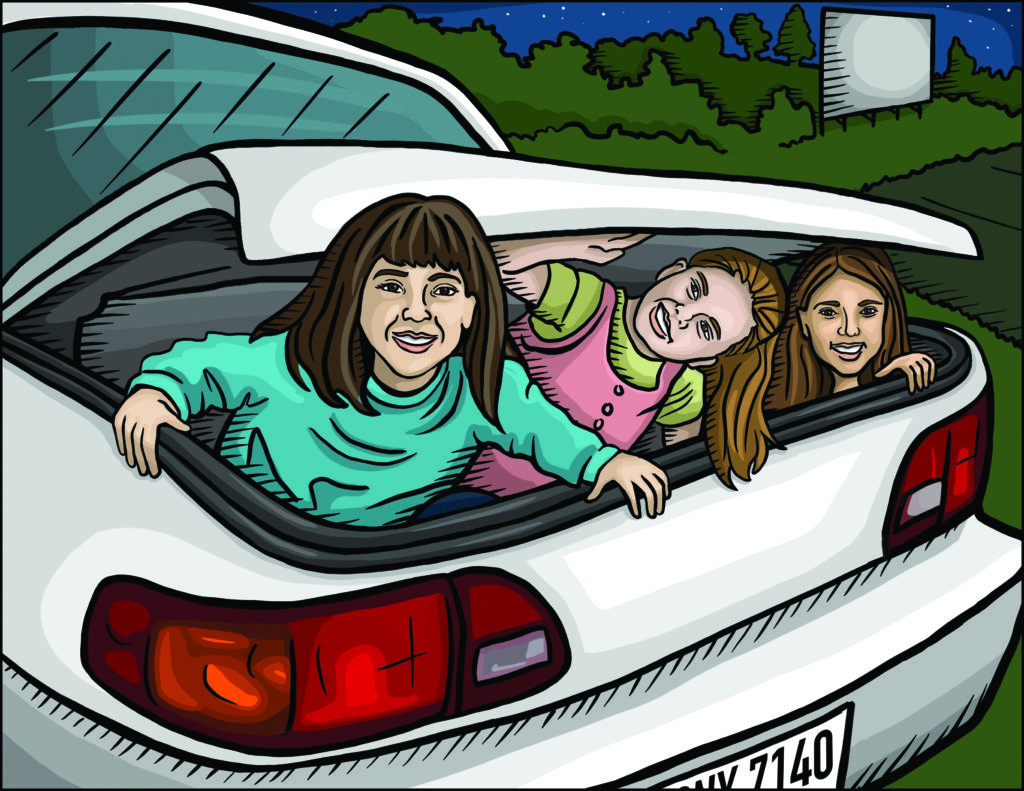
An ominous thump signaled the closing of the trunk above me, encasing me in darkness and an ear-splitting silence. My legs searched into the dark
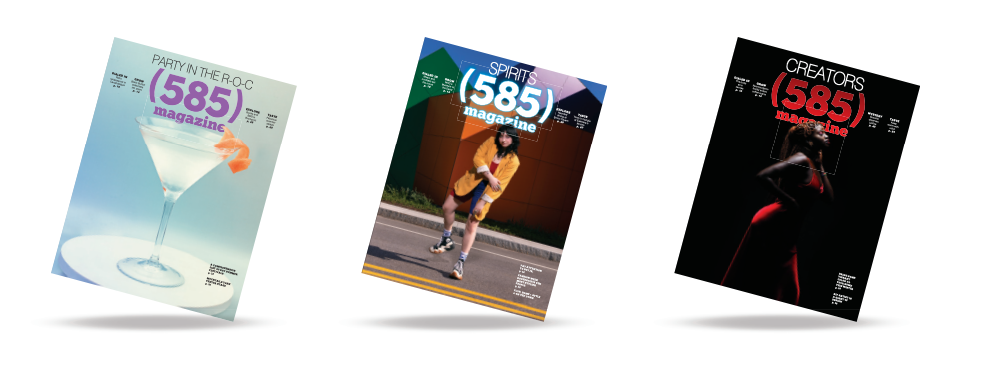
View our other publications: